Saturday, March 7, 2009:
We arrive in San Pedro Sula, Honduras around 12 noon, after approximately 24 hours of traveling. As soon as we clear customs (which took about an hour), we are greeted by our resident Honduran and club president, Eldy Quintanilla. We rented two vehicles from the airport in San Pedro Sula, a Mitsubishi Montero Sport and a Hyundai van (“el busito”), to drive the approximate four hours to Lapaera, Lempira. Eldy’s father, Mr. Quintanilla, escorted us to the San Pedro Sula city limits. We needed the escort for safety reasons because two carloads full of non-Hondurans attracted a lot of unwanted attention. We made it safely to the city limits and then waved goodbye
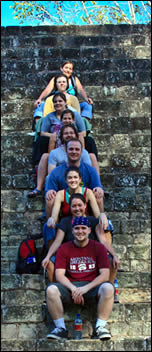
The MP crew poses at the Coan ruins.
to Mr. Quintanilla and were on our way.
The lengthy drive from San Pedro Sula to Lapaera provided ample bonding time for us as a group. In “el busito,” we were introduced to a goat named Bill Williams, an instant inside joke for the rest of the trip. Julie Wheaton, a 1L member in the group, told us the story about her mother’s goat which was lovingly named Bill Williams and we all found the name to be quite hilarious. From then on, every goat, cow, and horse was named Bill Williams.
Around 5:30 p.m., the group finally arrived at our host family’s house in Lapaera, Lempira, where we were greeted with welcoming arms and a veritable Honduran feast: carne asada, homemade salsa and tortillas, several types of beans, and cheese. The whole gang gathered on the back porch of the house (our main hang-out spot for the rest of the trip) happy and content with full bellies.
After dinner, we socialized with our host family, which was quite entertaining because only a few members of the group actually speak Spanish. Carias, our “dad,” and his wife have hosted many volunteers from the United States for over a decade. They were so very pleased to be hosting the Mission Possible group again this year. We presented them with a token of our appreciation, a framed picture of last year’s group. They absolutely loved it and immediately hung the framed photo in their living room. Also, we got to meet a Peace Corps volunteer named Abby who has been living in Lapaera for almost two years (she was there to meet last year’s group, too). Peace Corps Abby definitely had some amazing stories to tell about living in the small Honduran town and she provided the newcomers in the group with some great cultural advice and perspective (for example, girls should always dress modestly).
After a few more hours of talking and relaxing with the Carias family and their friends who stopped by to meet the “gringos” (note: we were reassured that this term is not derogative, but rather a loving nickname the people in Lapaera use to refer to Americans), the MP group began to disperse and get some much needed sleep after more than 24 hours of traveling. The sleeping arrangements were quite cozy. The entire Carias family slept in the master bedroom, two of the four guys in the group slept in the daughter’s room, the other two guys slept in the son’s room, and the nine girls slept on pallets in the main living area.
Sunday, March 8, 2009:
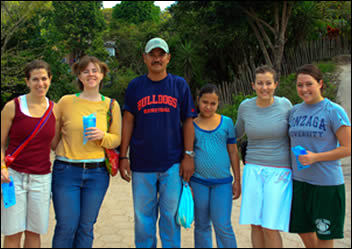
Carias, our host, and his daughter Marlen treated a group of us to an early morning tour of Lapaera.
Today is the first day of work. The boys and a few select girls were up early to go get our painting supplies for the week. Believe me, we needed a lot of paint. While the others were getting the supplies and a few others took advantage of a late morning to catch up on sleep, Carias took a handful of the remaining girls on a brief tour of the town. Marlen, Carias’ youngest daughter accompanied us on the tour.
First, Carias took us to the Roman Catholic Church, where they were getting ready for the afternoon services. Interestingly, the church highly discouraged cell phone use in the church, as evidenced by the numerous placards warning that you do not need to use a cellular device to talk to God. After the church, we walked over to the nearly-completed new bridge in Lapaera. Carias explained that once the bridge is completed, the town will feel more “united.” Apparently, the bridge construction project helped to bring the community even closer together.
Next, we were off to the “super mercado,” a great open outdoor market place. The multitude of sights and sounds (and smells) was overwhelming at times, but it was such a great experience to see the significance of the Sunday market.
Carias knows practically everyone in the village and he was introducing the group of MP girls with him as his daughters. This really speaks to the profound relationship between the Carias family and the Mission Possible group. We’re not so much guests as we are part of the family. On the way back to Carias’ house, we walked by the health center, the site of last year’s Mission Possible project. Carias explained how awesome the project was and how much it meant to Lapaera.
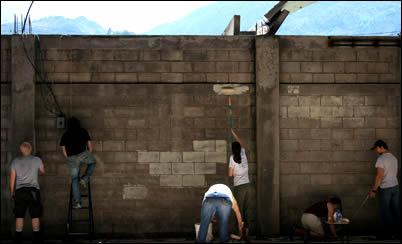
Painting the gymnasium.
We return to Carias’ house around 9:45 a.m., just in time to head to the school to begin work. Marlen guides us to the elementary school, where she is in the 5th grade. The school is empty today because it’s a Sunday. We worked for approximately two and a half hours on the gym, mainly doing the preparation work, sweeping the concrete walls, laying down newspaper and tarps, and taping the windows and doors.
A little after noon, we return to our house and are so excited to see that our Honduran mom, whom we lovingly called “Profe,” set out a delicious feast for us. We dined on a type of Honduran casserole with cheese, ham, eggs, and many vegetables. Profe even made a vegetarian version of the casserole for the four vegetarians in our group. All of us were pretty adamant about getting the recipe to take back to the States because it was so very delicious. After lunch, we returned back to the gymnasium (which is only a 10-minute walk or so from our house) to start rolling on the water-based undercoat.
At 4 p.m., it was stopping time for the day because we were being treated to yet another Honduran feast in a town named Gracias, approximately 45 minutes from Lapaera. Eldy, our madame presidente, has family who lives in Gracias, and each year they serve dinner for the Mission Possible group. We loaded up in our rental cars and headed to Gracias. Once we arrived at Eldy’s family’s house, we were just in time for dinner. There was so much food! Fried chicken, tamales, stuffed tortillas, two types of homemade salsa, beans, cheese, salad, ham, and fresh vegetables.
Eldy’s mom made the trip from San Pedro Sula to meet the whole gang. She constantly encouraged us to eat more. Eating several portions of the meal in Honduras is a sign of respect and lets the cook know that she did a superlative job in preparing the feast. All of us were so stuffed. After the meal, we were served a regional coffee that is well-known throughout Honduras and is grown right in Lapaera, Lempira. This is probably the most delicious coffee many in the group had ever tasted. Honestly, it is indescribable. It’s a very sweet coffee because it’s made ground with sugar.
After dinner, the group was in store for another treat. A trip to the hot springs! Gracias is home to naturally-fed hot springs. The springs were very relaxing . . . and hot! It was a great way to unwind and decompress after our traveling adventures and painting for most of the day. Around 8 p.m., we left the hot springs and headed back to Lapaera.
Traveling at night on the rocky, narrow roads is very dangerous. Also, we had to leave the springs at a decent hour so we did not disturb our host family when we returned home. One thing that is pretty constant throughout Honduras is the potholes! There are potholes galore on just about every road. Thankfully, our two primary drivers, Brad and Greg, were experts at navigating the pothole fields.
Once we arrived home, we all went directly to our respective sleeping areas and crashed.
Monday, March 9, 2009

Taking a break from painting to play with the kids.
The first full day of work. Every morning begins with an early rise (around 7 a.m. or so) and just about every Mission Possible member making their way to the coffee pot. Even those members that do not routinely drink coffee have found the coffee in Lapaera to be exceptional because there’s no need for cream or sugar. It’s that good. After everyone has awakened, the whole group walks the quarter mile or so to the elementary school.
This morning was a little different than yesterday because it’s a school day. All of the children were so excited to see the MP herd at their school, as evidenced by groups of them following us everywhere we went. The children eventually summoned the courage to open the sliding gate of the gymnasium, and little by little they began to pour into the gym. While we were so incredibly grateful and excited to see and play with the children, their presence was not entirely conducive to completing our work. We took about a half hour out of our morning to play a few games with the children. A little before 9 a.m., their teachers eventually rounded up all the children and shepherded them to their respective classrooms. Finally, we could get back to the task at hand until the kids had lunch and recess.
The painting job was going very smoothly with all the children safely nestled in their classes, until we realized that we were going to run out of paint. We decided to wash up for our early afternoon break a little early and put in the order for more paint. Around noon, the whole gang headed to the “parque” (park) to meet for lunch. We then walked to a local restaurant where we had an amazing meal of fried chicken and plantains. After everyone was feeling reenergized from our hearty meal, we all headed back to the school to see if any of the paint we had ordered was delivered. Sadly, it was not there. However, the lull in the work gave a few of us an opportunity to play with the kids some more.
Enter Edwin and Freddie. While all of the kids are absolutely amazing, these two little boys stole the hearts of the
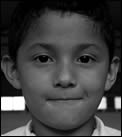 |
| Edwin won our hearts. |
Mission Possible group. Freddie is in the sixth grade and Edwin is in the fourth grade. We spent around an hour just playing games with all of the children. Their favorite game consisted of scaring the MP girls by finding frogs and chasing after us with them, while the MP boys stood by laughing hysterically.
Eventually, the ordered paint arrives and we get in another hour or two of painting accomplished. Around 5 p.m., we clean up for the day and head home for dinner. Usually after a long day of manual labor, all you want to do is take a long, hot shower and eat a delicious meal. Well, in Honduras, you can have the latter, but not the former. Water is a precious resource in Honduras. During the day (from 6 a.m. to 5 p.m.), the water in the town is virtually turned off. This means that there is no running water for toilets, faucets, showers, etc. To flush toilets, people typically fill large buckets with water and pour some of it into the commode to make it flush. Also, toilet paper is to be placed in garbage bins in lieu of the toilet because flushing with the buckets is much easier when there is no toilet tissue in the bowl.

- Unfortunately, the locals scored freely against the GU side.
Dinner this evening consisted of some of the most delicious taquitos and salsa ever. One of the best things about the trip was the food. Honestly, we were extremely well fed. After dinner, Carias, our host dad, and friends convinced us to play them in a game of soccer in the school’s gymnasium. Carias was so very excited for the battle royale: United States v. Honduras. It was a game of 5 on 5. While the MP crew made a solid effort at the start, we were eventually defeated by an astronomical amount. Carias, being the fair sportsman that he is, rearranged the teams so that each team had both Honduran and American players. It was so much fun.
After the game, we all headed back to the house and promptly went to bed.
Tuesday, March 10, 2009
Second full day of work and last day at the Lapaera elementary school. Again, it’s an early rise for the group. Thank
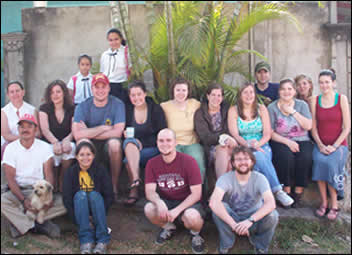
- Our last morning with our host family.
goodness for the coffee. We head to the school extra early this morning so that we can finish the job before early afternoon, when we were scheduled to start working at the other elementary school higher in the mountains. Before we are completely finished painting the gymnasium, we take a break to hand out backpacks to two students in each classroom.
The backpacks are filled with school supplies donated by the Gonzaga community and the Mission Possible group. Each grade (1st through 6th) has 3 sections. We handed out a backpack to the neediest boy and girl in each section. Although, we handed out the gifts under the guise that the best behaved children in each class were receiving a special gift on account of their great behavior. Each member grabbed a couple of backpacks and we took turns calling out names in each classroom. We would say “mi amigo especial es . . . “ (my special friend is) and then the children would come up to claim their prize. Some of the older grades prepared a few English phrases and would recite them to us as we entered. Other classes would sing us Honduran songs. It was such a wonderful experience.
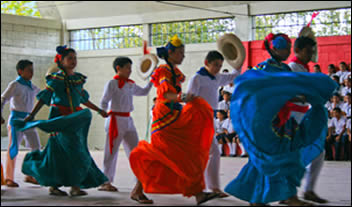
- The schoolchildren prepared a presentation for us.
After we finished handing out all of our backpacks, we headed back to the gymnasium for a special presentation. The entire school had prepared an approximate 45-minute program for us to demonstrate their gratitude for our hard work. The presentation consisted of various skits, songs, and dances performed by children and teachers alike. During this presentation, we are introduced to the myth of “La Sucia.” It’s a tale fashioned to warn against the dangers of following a beautiful woman. Most of the children were so excited for the skit, while the younger ones were slightly terrified because La Sucia is a very scary witch-type figure. Throughout the program, the MP group was thanked profusely by the teachers and students. They were really very grateful.
When the presentation was completed, we had a few more touch-ups to do in the gym. Once finished with those, we headed back to the house so that we could load up in the rental cars and head to the other elementary school. This school is located a little higher up in the mountains and is much more impoverished than the Lapaera elementary school. In this school, there are only two teachers and six grades. Each teacher teaches three grades at the same time, similar to a one-room school house. Our task at this school is to paint the two classrooms. Before we delve into our paint, we are served lunch. Spaghetti was on the menu! The whole group loved the spaghetti, mostly because it was so unexpected.
After lunch, we quickly paint the first coat in the two classrooms. Because the rooms were not cinder block like the gym, the painting went very smoothly and we were finished within an hour. Instead of waiting for the paint to dry to do the second coat, we opted to call it a day and headed back home. Once home, we ate dinner, which consisted of fried plantains. We were also in store for a treat! Carias and the whole family were taking the MP group to another hot springs location. The hot springs are so relaxing, most especially after half a week of grueling manual labor. Also, it was an incredible bonding experience with the family. While the majority of the MP members don’t speak Spanish and the Carias clan doesn’t speak English, we are still able to communicate very effectively by gesticulating and pointing. The hot springs really solidified the bond between the members themselves, as well as with the family.
Wednesday, March 11, 2009

- Handing out backpacks to the children at the mountain school.
Last day of work. Again, the group is up very early. Today, we are handing out backpacks filled with school supplies to every single child at the mountain elementary school. We arrive at the school a little after 8 a.m. and quickly finish painting the classrooms. Because the walls are smooth concrete and there are 13 of us, we finish within an hour. The children have to have class in the breezeway outside the classrooms because we are occupying their classrooms.
After we finish painting, we head out to the playground area to hand out backpacks. We start with the first grade and work our way up the sixth. The children are really excited because we put some fun goodies in their bags. It honestly was such a rewarding feeling to help those less fortunate than ourselves. Once every child has been presented with a backpack, we head over to the basketball court to play a few games with the kids. The winner of each game was given a special gift such as a purse, coloring book, sweatshirt, etc. The games we played with the kids were mar y tierra (land and water), pato pato ganzo (duck duck goose), and red light/green light.
We spend an hour or two just playing games with the children and getting to know them better. Also, they reenacted the “La Sucia” skit for us. The whole group really began to love the legend of La Sucia. After the games were finished, we had lunch. They served us a very delicious casserole and very fresh fruit. When we finished lunch, we played with children for a little longer and then we packed up and headed home.
Tonight, we decided to cook dinner for the family as a small token of our appreciation for their amazing hospitality. A few of us went from market to market trying to find the perfect meal. We settled on pasta and sausage. It was so very delicious. The rest of the night was spent with Carias and his family because it was our last night in their house. Omar, Carias’ friend, stopped by and presented each of us with a small gift. The boys received a small, ceramic pot and the girls received beautiful bracelets. Everyone was a little sad tonight because we all knew we had to leave early the next morning for Copan.
Thursday, March 12, 2009
Group fun day. Every year, Mission Possible reserves one day of the trip for activities that are “fun,” meaning no work. This morning we awakened early again so that we could get on the road and arrive in Copan around lunchtime. We took several pictures with the family this morning. There were lots of hugs all around. Carias wept a little and said that we must come back next year. After all the good-byes, we loaded up in the cars and embarked upon the three- or four-hour drive to Copan.
We chose Copan as the site of our fun day because the majority of the MP members wanted to see the Mayan ruins.
We arrive in Copan a little after noon. After we get settled in our hostel, Hostal de La Manzana Verde (Hostel of the Green Apple), we head to the ATM to get some lempira. Next stop, lunch! The group splinters at this point and several members go their own ways. There’s so much to see and do in Copan. Also, safety is not as severe a concern in Copan because it’s a very tourist-friendly place. A few of us head to the Red Frog for lunch. We all order very American fare: hamburgers, French fries, sandwiches, etc. We relax for awhile and enjoy the view from the roof of the Red Frog.
Around 2 p.m., those who have not seen the ruins, head over to the site. We are immediately greeted by Julio, our eventual tour guide. Julio spoke very good English and was very knowledgeable about the ruins. Julio’s animated style and extensive knowledge made the ruins tour very, very fun.
After the tour was over, we headed back to the hostel to relax for a bit. While there, we met Rowena, a traveler from the UK. She accompanied us to dinner at Momo’s, a steak house of sorts. All of us dined on relatively inexpensive steak, excluding the vegetarians, of course. After dinner, we have a group social back at the Red Frog. We met a group of young Canadians also doing mission work. Also, we were celebrating a member’s birthday. It was a great end to our time spent in Honduras.
Friday, March 13, 2009
The group awakens around 5 a.m. so that we can make it to the airport in time for our noon flight out of San Pedro Sula. Before we even make it out of Copan, one of the rental vehicles gets a flat tire. How many law students does it take to change a flat tire? The answer is 10. Only because 3 of us decided there were too many cooks in the kitchen and stayed inside the other car.
We made excellent time to the airport and had an extra hour or so to regroup and wait for our flight. We land in Atlanta as scheduled and make it through customs with no major snags. All of us grab food and make it to our flight on time. We arrive in Seattle around midnight and all but three members make the executive decision to drive back to Spokane tonight.
Approximately 40 miles from Spokane, around Ritzville, Washington, the vehicle I was in was involved in an accident. While the accident was very serious, all of the members received only minor injuries and are doing just fine. I did shatter my collarbone in the accident and have subsequently undergone surgery to have it repaired. I am doing spectacularly now. We want to thank everyone for their concern and well wishes.



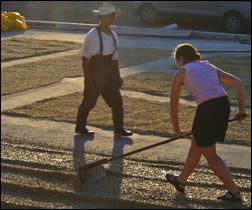









 Hi! Welcome to the Mission Possible blog!
Hi! Welcome to the Mission Possible blog!